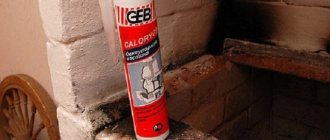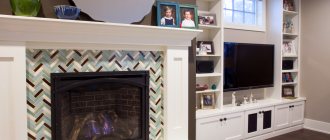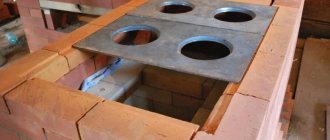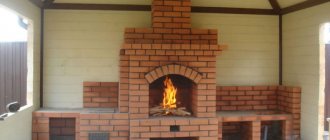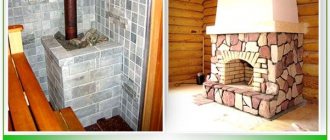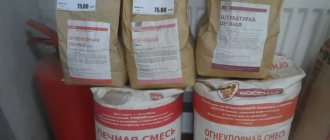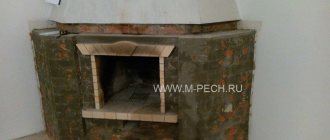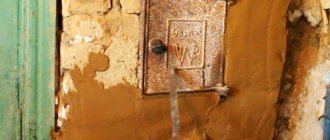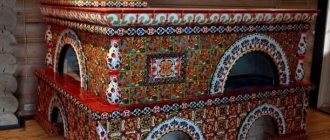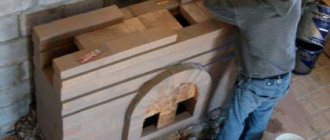The laying of fireplaces and stoves has a number of features, because the structure will be constantly exposed to high temperatures. In this regard, for the process you need to choose a special glue for stoves and fireplaces; it will help preserve the structure and will not collapse or crack in such conditions. More details about what properties a high-quality fire-resistant adhesive should have and what types exist will be discussed below.
Heat-resistant adhesive for stoves and fireplaces
Heat-resistant mixtures are produced in separate types for bricklaying or the base and cladding of the finished structure.
Heat-resistant adhesive for ovens must have:
- fire resistance;
- plasticity to create an even coating;
- ability to withstand temperature changes.
The heat-resistant compound provides a protective layer between the fireplace and the tiles. Helps avoid deformation of the cladding.
What components should be included?
Plasticizers and synthetic additives are added to the composition of ready-made dry mixtures. In addition, the following components are added to heat-resistant fireplace adhesive:
- sand;
- chalk;
- cement;
- mineral inclusions;
- pulp;
- fireclay
The adhesive composition varies depending on the characteristics and popularity of the manufacturer.
Masonry mortar for stoves and fireplaces
Recommendations for use
How to work with glue is described in detail in the instructions. But there are some general recommendations .
- The surface for cladding must be thoroughly cleaned, especially from oil and grease stains - they reduce adhesion. If the base is highly absorbent, it is first treated with a primer.
- Dry mixtures are prepared 2 hours before work: after mixing, they need about an hour to settle. You need to dilute the glue with clean water, preferably filtered.
- To obtain a homogeneous mixture, it is recommended to use a drill with an attachment or a mixer.
- The adhesive is applied in a thin layer, both when installing tiles and when laying bricks. This is his advantage.
Heat-resistant and heat-resistant mixtures are used not only for the construction of stoves or laying porcelain stoneware. They are used in the repair of heaters, microwaves, and electric ovens.
Kinds
Depending on the composition and additives included in it, there are different types of glue for ovens. The components filling it also depend on the purpose of the substance. For the chimney you need heat-resistant, for the base - heat-resistant, for masonry - heat and moisture resistant. Adhesives are sold in the form of a ready-made solution or dry powder. The liquid mixture is similar to jelly and is immediately ready for use. A solution is prepared from the dry substance by diluting it with water.
The difference between heat-resistant glue and heat-resistant glue
Adhesives for lining stoves and fireplaces have special plasticity. Universal compositions are preferable for work, as they save time and effort. But they do not always correspond to the desired temperature.
Refractory mixtures do not change their properties when exposed to an open flame for 180 minutes. They are also resistant to chemicals. Heat-resistant can withstand heating up to 1000°C. Heat-resistant retain their quality under prolonged heat exposure up to 140°C.
A universal composition, the disadvantage of which is its high price, is a heat-resistant material with soapstone chlorite as a plasticizer. The filler is quartz sand, binding components: kaolin, aluminosilicate cement.
Pros:
- excellent adhesion;
- heat-intensive;
- with good thermal conductivity;
- the seams are strong;
- heat resistance up to 1500°C.
Which one should I take?
Knowledge of the physicochemical properties of the oven adhesive base greatly simplifies its choice, but it is also necessary to keep in mind the scope of application specified by the manufacturer. For example, Terracotta Superfireplace is a good masonry adhesive, but the manufacturer guarantees the reliability of the cladding on it only if it is also made of terracotta tiles. The base of the Terracotta Superfireplace is clay-cement-fireclay, and therefore facing materials need to be placed on it in belts of 2-4 rows with breaks for the glue to set. How to line a stove with terracotta, see next. video:
Video: finishing the stove with terracotta
Glue Plitonit SuperKamin Ogneupor can also be used for masonry, it is a good heat-resistant adhesive for the oven, but the best domestic one for this purpose is K-77, which is essentially an oven masonry adhesive based on aluminosilicates. Besides the expensive ScannMix , it is perhaps the only option for laying the base of a fireplace/stove, because... maintains high sub-zero temperatures, does not allow moisture and its vapors to pass through.
Profix , Hercules and Ivsil termix adhesives are intended for tiles, but the first according to TKR “specializes” in tiles, Hercules is suitable for any cladding of a fireplace or stove tent, incl. heavy (natural stone), and Ivsil termix has proven itself well on the portals of wood-burning fireplaces with fireclay open fireboxes. As for Polymin P11 and Ceresit C16 and C17, these are heat-resistant general purpose adhesives; the lining on them holds tightly only if the fireplace has a factory-made metal firebox with glass.
Note: there is a fairly wide selection of tile stove adhesives of Belarusian and Ukrainian production on sale. However, the upper limit of heat resistance of the former is, as a rule, 180, and for the latter 150 degrees, which is sufficient, at best, for cladding a fireplace tent with a finished closed firebox. Are they saving on raw materials, or what?
How to choose
The adhesive is selected in accordance with the customer’s financial capabilities and the conditions in which the composition will subsequently be located. Operating temperature, setting speed, environmental friendliness and resistance to external factors are important.
| Name | Price |
| 1. Astrochim AC-9315 | up to 100 rub. |
| 2. KS universal glue | up to 900 rub. |
| 3. Founds oven mold AC150 | up to 800 rub. |
| 4. IRFIX +1500 High Temperature Sealant | up to 250 rub. |
| 5. UHU 46670 Metall | up to 300 rub. |
Popular brands
The level of quality from reliable manufacturers also matters.
"Stove Man"
The glue is ready to go. Contains additives that increase resistance to temperatures of 1600°C. Suitable for lining stoves and fireplaces. Dries completely within a week. With the help of the “Stove Maker”, porcelain tiles, tiles, and finishing stones are installed. The glue is durable and highly flexible.
Terracotta
The adhesive for masonry stoves is based on terracotta clay. Suitable for installation of fireplaces. Various types of tiles, brick, natural and artificial stone are attached to it. Requires pre-soaking for an hour.
Lay the brick in 2-3 rows, then stop working until the composition hardens.
PalaTERMO-601
The universal composition can withstand heating up to 150°C. Designed for cladding stoves and fireplaces with clinker tiles, porcelain tiles, and finishing stones. Fireproof tile adhesive copes with sudden temperature changes from hot to freezing. It consists of high quality cement, a complex of modifying additives that make the adhesive solution elastic.
Advantages
Compared to traditional cement-sand mortar or red clay, adhesive for refractory bricks has the following advantages:
- Resistance to the external environment and chemical compounds.
- Plasticity, which allows you to fill small chips on the brick and adjust the masonry within 5-15 minutes after application.
- Maintains the thickness of the seams, resulting in virtually no shrinkage.
- The heat resistance of the finished structure is close to 1400 °C.
The composition of the glue from different manufacturers may differ slightly, but all mixtures contain: cement, fireclay fibers, sand, mineral additives and synthetic components. Today, Profix, Terracotta and Scanmix Fire products are popular on the market.
How to make it yourself
Previously, only clay was used for laying stoves. With the development of the chemical industry, a heat-resistant composition became the fastening material.
But methods of creating solutions with your own hands are still popular. The main masonry is mounted on a mixture of clay, sand and cement. And the structure is lined with heat-resistant glue for stoves and fireplaces.
Clay composition
To create the main structure of the furnace and also for its lining, clay mortar is used. It is prepared like this: add 1 part filler to 2 parts clay. The mixture is diluted with water. The filler is shavings, sawdust, and construction sand.
To give greater strength to the clay solution, add table salt. 150-200 g of the substance are dissolved in a 10 liter bucket of water.
A clay-sand mortar is also mixed as masonry.
How to prepare clay mortar for laying a stove with your own hands.
Cement-clay mixture
The composition has high adhesive properties. Prepared from several parts:
- ¾ sand;
- ¼ chalk;
- ¼ clay;
- ¼ cement.
The mixture is prepared in dry form, first without clay. It is added at the end. Liquid glass is suitable as an additive.
The composition is suitable for installing large tiles and heavy tiles.
Mortar
The mixture is prepared from sand and lime in a 3:1 ratio. The solution is heat resistant. Used for brickwork. It is not recommended to apply cladding to it.
Cement mortar
Cement is less often added to the composition for laying a stove. You will need 750 g of it per bucket of water. Used for finishing horizontal surfaces.
Sand-cement mortar is used for the base of the furnace, when sealing joints. The composition proportions are as follows: 2 parts sand: 1 part cement. The solution is prepared as follows:
- construction sand is mixed with cement in the required quantity;
- mix well together;
- pour water so that the composition is mobile.
The composition should be squeezed out of the seam without much pressure.
To strengthen the masonry and increase gas-tightness properties, treat the seams with heat-resistant silicone sealant. It will prevent possible deformation of materials during thermal expansion.
Making a composition with sand, cement and heat-resistant glue with your own hands. Professional method.
How to work with glue
Before you begin, you need to prepare the foundation. The surface on which the heat-resistant adhesive will be applied is first cleaned of dirt and dust. Severe cracks are sealed with putty.
Before applying heat-resistant adhesive to the wall, it is necessary to prime the surface. The composition is also selected to be heat-resistant.
Before laying, soak the facing tiles for the stove or fireplace in water for a short time. This will improve adhesion to the adhesive.
The bonding agent is diluted according to the instructions.
Installation of the device using oven glue:
- The diluted or prepared composition is applied to the surface using a notched trowel.
- The glue line should not be higher than 1 cm.
- Lay tiles or bricks.
- Important! This must be done within 10 minutes, otherwise the glue will dry out.
- Press firmly and hold for 4-5 minutes.
- You must wait 48 hours before grouting.
An adhesive compound with heat-resistant properties has no application features or contraindications. It is important to follow the instructions for use and safety precautions.
Other selection factors
When purchasing fireproof adhesive for a tile stove, other factors are taken into account:
- Frost resistance is an important factor when the stove is located in a room with non-permanent occupants, when there is a possibility of negative temperatures in winter. If the glue does not have this property, there is a risk of cracking the tiles.
- Material – more durable tiles require adhesive with a higher level of adhesion.
- The cladding factor - stone reduces adhesion, but fireclay brick increases it.
- Operating mode - if the stove is often heated and extinguished, this puts a greater load on the materials than a constantly operating device.
- Additional loads, vibrations. They affect long-term operation and violate the properties of materials.
Based on these factors, you can choose the ideal glue. Of the different options, you need to choose the one that best suits the operating conditions.
Safety regulations
Hot melt adhesive, like other building materials, due to its chemical composition, has qualities that require compliance with safety measures.
To protect your respiratory system when working with dry glue in powder form, use a respirator. Protect your eyes with glasses.
If the already diluted composition gets on the skin, it is necessary to immediately remove and rinse with water. Otherwise, a chemical burn may occur.
The use of heat-resistant compounds for laying stoves and fireplaces allows you to achieve excellent results. Subsequently, the structure will be exposed to high temperatures. And it is the fireproof glue that will prevent the device from falling apart.
Adhesive mixtures, ready to use
Manufacturers offer ready-to-use adhesives that do not require adding water. The material is convenient to use, but it is more expensive than dry mixtures. The most popular brands are:
- “Parade K-77” is a fire-resistant adhesive that retains strength at temperatures reaching 800˚C . The material is not used on plastered surfaces.
- “Terracotta mastic” is a universal solution for finishing work, minor repairs and construction.
- Mixonit Termo is a mastic for lining outdoor stoves. The material does not deform under the influence of high humidity and negative temperatures. The composition hardens quickly, so it is only suitable for professionals or minor repairs.
Fireclay bricks are used to build fireplaces and stoves. Below we will not talk about the advantages of fireclay material, but about which glue for fireclay bricks is better to choose, how to glue fireclay to metal.
Heat-resistant glue has undoubted advantages, for example, the speed of mixing the solution and the stability of its consistency, which is only a plus for novice builders.
The cost of the adhesive mixture for fireclay bricks is approximately equal to the cost of a dry mixture of oven clay. Only the speed of preparation of the clay-cement mixture is at least a couple of hours, and it is realistic to knead the finished dry mixture in about 30 minutes.
And if you prepare a solution for the brickwork of a fireplace from natural ingredients, the preparation time will increase to 72-96 hours. Another advantage of the dry mixture is its high adhesion; it will speed up and facilitate the construction stage of lining the furnaces.
In principle, it is possible to completely trust the load-bearing masonry for an entire furnace to glue for fireclay bricks, but you will have to carefully monitor the behavior of this material during operation. But it’s possible to create a fireplace or fire stove without any worries.
By the way, both forge and muffle furnaces can be classified as technological furnaces. Unfortunately, the topic of the article does not provide for all these nuances; here we will talk exclusively about heat-resistant glue, which holds temperatures up to 1800◦C.

